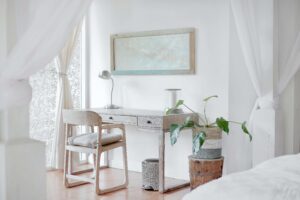
For as long as COVID-19 continues—and possibly for a while afterwards, increasing numbers of people will work from home. For some companies, having employees work from home makes so much sense that they’ve made the switch permanent!
If you or a family member are working from home, or preparing to, this is the ideal time to set up a home office. Even if you’re not working from home right now, having a home office setup can provide you and other family members with a quiet place for work, homework, and other important activities. Check out these home office ideas to help you get started with your work-from-home setup!
1. Choose the Right Space
Whether you’re working from home on a temporary or a permanent basis, one of the most important aspects of your home office is its location. If you expect to get quality work time in at your home office, then it should be in a quiet part of the house, away from noisy places like the kitchen and living room. If you don’t have room for a dedicated home office, is there a guest bedroom that can do double-duty? In a pinch, even a large closet can provide enough room for a desk and a chair.
What If You Don’t Have the Perfect Space?
If you have kids, or there are extended family members living with you, it may be hard to find the perfect spot for a home office. That’s okay! It’s best if your workspace has a door that you can close for privacy, but if all you have is a folding screen, that can work too. You can still work from home effectively even without the perfect workspace.
You may not be able to designate a separate room for a home office, but it does help if you can put some boundaries in place to create an office space. For instance, can you put a desk or table in a quiet corner and designate that your home office?
2. Have the Home Office Mindset
Just as important as choosing a good spot for a home office is the right mindset: Work and home are two separate places, even if your home office setup is a part-time guest room or a converted closet! Especially if you don’t have an office that’s closed off from the rest of the house, it’s helpful to separate home and work in your mind. That way, you can mentally make the transition from home to work each time you enter your workspace. This helps your brain switch over to work mode. You’ll feel more focused and productive when you’re working from home.
If you’re new to working at home, this may be difficult to do, especially if both you and your partner’s offices are now in the house. Children at home can make it even tougher! But having a space that you mentally designate as “for work only” can help you focus on work when you need to.
It can also be helpful to try and keep regular working hours, like 9 AM to 5 PM with an hour break for lunch. Just maintaining a routine can help you stay on track with work, but it can also prevent work from bleeding over into family time.
3. Make Sure You Can Work Comfortably
Working at home effectively isn’t just about the location of your home office. The equipment you use is important too. Focus on making your home office setup ergonomic, meaning you can work comfortably for long periods of time, without stooping or straining.
Worksurface and Seating
You need a work surface that’s the right height for your height. The industry standard desk height is 29 inches, but the most comfortable desk for you may be a little lower or a little higher, depending on your height and proportions. The best chairs and desks for home office settings are adjustable, so you can get the perfect height on your work surface and good lumbar and posture support for your back.
Computer Setup
When seated at your desk, your computer screen should be around 20 inches away from your eyes. The proper monitor height should allow you to sit straight in your chair and look straight ahead at the top third of the screen. This ensures you don’t have to hunch your back or strain your neck or shoulders to see what you’re doing.
When you’re sitting this way, your forearms should be parallel to the ground, with your wrists straight and your fingers lightly resting on your keyboard. In this position, your wrists and forearms experience the least amount of strain, which reduces your risk of repetitive strain injuries.
If your home office setup doesn’t allow for this—and a new desk and chair aren’t in your budget—you may need to get creative to make sure you can work comfortably. For instance, a monitor riser may give your computer the necessary height if it’s too low. Don’t have a riser? A sturdy box or a couple of books can work too!
Lighting
Lighting is often forgotten when thinking about how to work from home, especially when a home office setup has to come together quickly. But lighting is quite important. Whether it’s too much or too little, bad lighting can cause serious eye strain.
The best lighting for a home office is indirect lighting, meaning the light source isn’t in your field of vision and doesn’t cause glare on your monitor. Ideally, your main light source should be an overhead lighting fixture. If you’re using lamps for light sources, make sure they don’t cause glare on your computer screen and aren’t in your field of vision when you’re working. Either situation can cause eyestrain and headaches.
4. Don’t Neglect Storage
A cluttered desk—and office—is a tough place to work. Acquire a few organization solutions for your space, and free up your mind to concentrate and create.
You’ll find what works for you, but it could be:
- Cubbies with baskets to hide cords and other electronics
- Trays to sort papers
- A filing cabinet to store away sensitive documents
- Hanging shelves to keep pencil holders, a stapler, scissors, etc. off your desk
5. Avoid Distractions
When you’re setting up your home office, it may be tempting to add decorative items to make the space more attractive. The problem is, too much clutter can be counterproductive. It’s often better to go for a minimalist desk setup in a home office. There are already plenty of distractions around when you’re working at home! Instead of adding to them by way of desk décor, go for a minimalist approach and include only what you need. Add pops of color with a mouse pad, coffee mug, or penholder—that way everything on your desk is both fun and functional!
6. Think Long-Term
If you know you’ll be doing the work-from-home thing for the long haul, it makes sense to invest more in your home office setup. On the other hand, if your employer has already told you that working from home is definitely temporary, there’s probably no need to make long-term arrangements.
But if you know for sure that working at home is in your immediate future—or your present, why not invest in a comfortable setup that works for you? For instance, if you’re concerned about the effects of spending a lot of time in sedentary activities, think about getting a standing desk. Or opt for a desk that you can adjust on the fly for either sitting or standing.
Another optional investment that can make your work-from-home life much more convenient is a dual monitor setup. Say goodbye to juggling windows—with a dual setup, you have twice as much screen space, and multi-tasking is infinitely easier. Some other long-term needs might include:
- High-speed internet
- A mechanical keyboard; especially if you’re a writer or a coder
- An ergonomic mouse
- A whiteboard or corkboard for brainstorming sessions
A Well-Designed Home Office Helps You Stay Productive
Whether you’re working at home by choice or COVID-19 has temporarily changed your situation, having the right home office environment can make a big difference in how productive you are at home. It’s always a good thing to improve your surroundings so they work better for you—carving out a home office space that’s quiet and private is a great first step!



